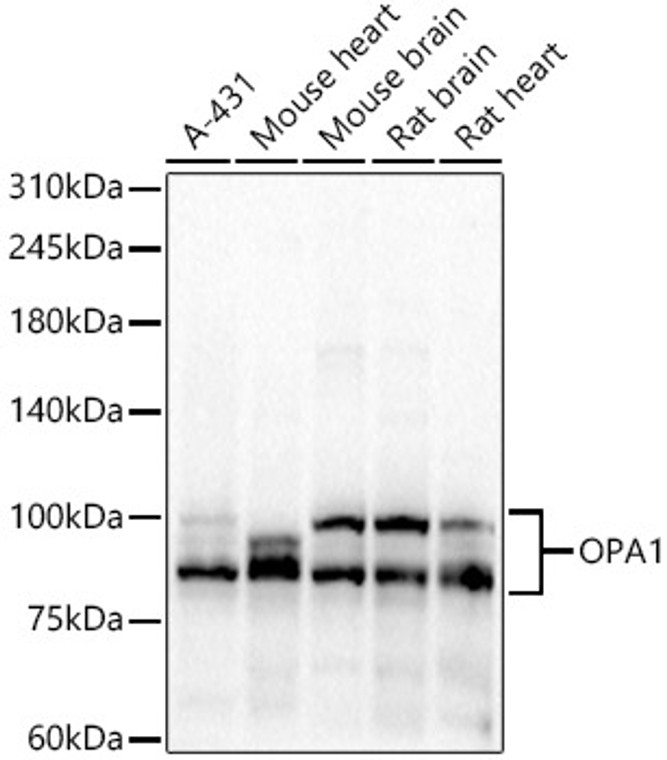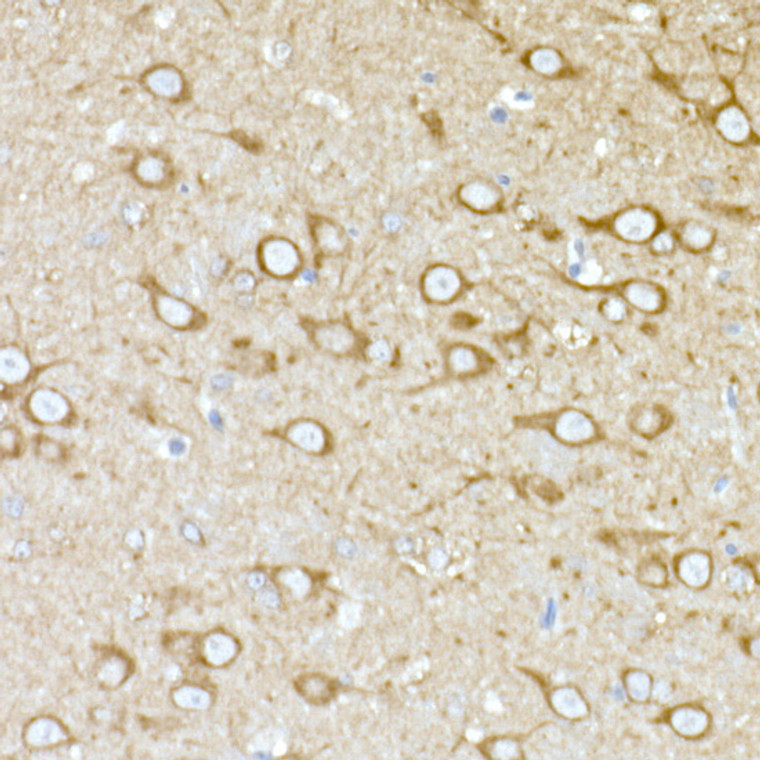| Host: |
Rabbit |
| Applications: |
WB/IF |
| Reactivity: |
Human/Mouse/Rat |
| Note: |
STRICTLY FOR FURTHER SCIENTIFIC RESEARCH USE ONLY (RUO). MUST NOT TO BE USED IN DIAGNOSTIC OR THERAPEUTIC APPLICATIONS. |
| Short Description: |
Rabbit polyclonal antibody anti-OPA1 (200-960) is suitable for use in Western Blot and Immunofluorescence research applications. |
| Clonality: |
Polyclonal |
| Conjugation: |
Unconjugated |
| Isotype: |
IgG |
| Formulation: |
PBS with 0.05% Proclin300, 50% Glycerol, pH7.3. |
| Purification: |
Affinity purification |
| Dilution Range: |
WB 1:2000-1:8000IF/ICC 1:50-1:200 |
| Storage Instruction: |
Store at-20°C for up to 1 year from the date of receipt, and avoid repeat freeze-thaw cycles. |
| Gene Symbol: |
OPA1 |
| Gene ID: |
4976 |
| Uniprot ID: |
OPA1_HUMAN |
| Immunogen Region: |
200-960 |
| Immunogen: |
Recombinant fusion protein containing a sequence corresponding to amino acids 200-960 of human OPA1 (NP_056375.2). |
| Immunogen Sequence: |
SESDKHFRKVSDKEKIDQLQ EELLHTQLKYQRILERLEKE NKELRKLVLQKDDKGIHHRK LKKSLIDMYSEVLDVLSDYD ASYNTQDHLPRVVVVGDQSA GKTSVLEMIAQARIFPRGSG EMMTRSPVKVTLSEGPHHVA LFKDSSREFDLTKEEDLAAL RHEIELRMRKNVKEGCTVSP ETISLNVKGPGLQRMVLVDL PGVINTVTSGMAPDTKETIF SISKAYMQNPNAIILCIQD |
| Tissue Specificity | Highly expressed in retina. Also expressed in brain, testis, heart and skeletal muscle. Isoform 1 expressed in retina, skeletal muscle, heart, lung, ovary, colon, thyroid gland, leukocytes and fetal brain. Isoform 2 expressed in colon, liver, kidney, thyroid gland and leukocytes. Low levels of all isoforms expressed in a variety of tissues. |
| Post Translational Modifications | PARL-dependent proteolytic processing releases an antiapoptotic soluble form not required for mitochondrial fusion. Cleaved by OMA1 at position S1 following stress conditions. Isoform 2: Cleavage at position S2 is mediated by YME1L. Cleavage may occur in the sequence motif Leu-Gln-Gln-Gln-Ile-Gln (LQQQIQ). Isoform 3: Cleavage at position S2 is mediated by YME1L. Cleavage may occur in the sequence motif Leu-Gln-Gln-Gln-Ile-Gln (LQQQIQ). Isoform 4: Cleavage at position S2 is mediated by YME1L. Cleavage may occur in the sequence motif Leu-Gln-Gln-Gln-Ile-Gln (LQQQIQ). |
| Function | Dynamin-related GTPase that is essential for normal mitochondrial morphology by regulating the equilibrium between mitochondrial fusion and mitochondrial fission. Coexpression of isoform 1 with shorter alternative products is required for optimal activity in promoting mitochondrial fusion. Binds lipid membranes enriched in negatively charged phospholipids, such as cardiolipin, and promotes membrane tubulation. The intrinsic GTPase activity is low, and is strongly increased by interaction with lipid membranes. Plays a role in remodeling cristae and the release of cytochrome c during apoptosis. Proteolytic processing in response to intrinsic apoptotic signals may lead to disassembly of OPA1 oligomers and release of the caspase activator cytochrome C (CYCS) into the mitochondrial intermembrane space. Plays a role in mitochondrial genome maintenance. Dynamin-like 120 kDa protein, form S1: Inactive form produced by cleavage at S1 position by OMA1 following stress conditions that induce loss of mitochondrial membrane potential, leading to negative regulation of mitochondrial fusion. Isoforms that contain the alternative exon 4b (present in isoform 4 and isoform 5) are required for mitochondrial genome maintenance, possibly by anchoring the mitochondrial nucleoids to the inner mitochondrial membrane. |
| Protein Name | Dynamin-Like 120 Kda Protein - MitochondrialOptic Atrophy Protein 1 Cleaved Into - Dynamin-Like 120 Kda Protein - Form S1 |
| Database Links | Reactome: R-HSA-169911 |
| Cellular Localisation | Mitochondrion Inner MembraneSingle-Pass Membrane ProteinMitochondrion Intermembrane SpaceMitochondrion MembraneDetected At Contact Sites Between Endoplasmic Reticulum And Mitochondrion Membranes |
| Alternative Antibody Names | Anti-Dynamin-Like 120 Kda Protein - Mitochondrial antibodyAnti-Optic Atrophy Protein 1 Cleaved Into - Dynamin-Like 120 Kda Protein - Form S1 antibodyAnti-OPA1 antibodyAnti-KIAA0567 antibody |
Information sourced from Uniprot.org
12 months for antibodies. 6 months for ELISA Kits. Please see website T&Cs for further guidance












